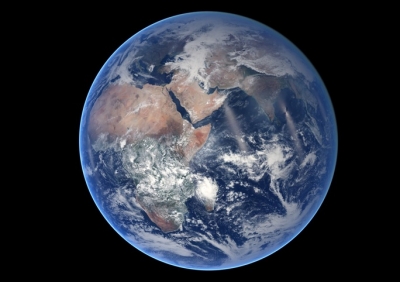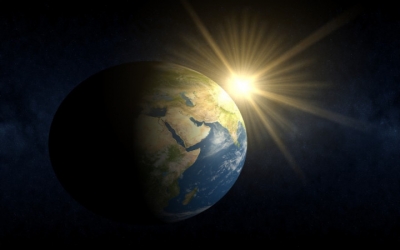
When mars first formed it had a much thicker atmosphere than it does today. Because the planet’s gravity is not very strong, this atmosphere gradually escaped into space. The climate became increasingly cold, and all the water on Mars froze. Today, the water on Mars exists only as an icy, permafrost layer deep in the soil. Temperatures in Mars’ Polar Regions are so low that carbon dioxide in the atmosphere freezes, covering sheets of water ice with a layer of frosty crystals of dry ice.
Almost all water on Mars today exists as ice, though it also exists in small quantities as vapor in the atmosphere. What was thought to be low-volume liquid brines in shallow Martian soil, also called recurrent slope lineae, may be grains of flowing sand and dust slipping downhill to make dark streaks. The only place where water ice is visible at the surface is at the north polar ice cap. Abundant water ice is also present beneath the permanent carbon dioxide ice cap at the Martian South Pole and in the shallow subsurface at more temperate conditions. More than 21 million km3 of ice have been detected at or near the surface of Mars, enough to cover the whole planet to a depth of 35 meters (115 ft). Even more ice is likely to be locked away in the deep subsurface.
Some liquid water may occur transiently on the Martian surface today, but limited to traces of dissolved moisture from the atmosphere and thin films, which are challenging environments for known life. No large standing bodies of liquid water exist on the planet's surface, because the atmospheric pressure there averages just 600 pascals (0.087 psi), a figure slightly below the vapor pressure of water at its melting point; under average Martian conditions, pure water on the Martian surface would freeze or, if heated to above the melting point, would sublime to vapor. Before about 3.8 billion years ago, Mars may have had a denser atmosphere and higher surface temperatures, allowing vast amounts of liquid water on the surface, possibly including a large ocean that may have covered one-third of the planet. Water has also apparently flowed across the surface for short periods at various intervals more recently in Mars' history. On December 9, 2013, NASA reported that, based on evidence from the Curiosity rover studying Aeolis Palus, Gale Crater, contained an ancient freshwater lake that could have been a hospitable environment for microbial life.
Many lines of evidence indicate that water ice is abundant on Mars and it has played a significant role in the planet's geologic history. The present-day inventory of water on Mars can be estimated from spacecraft imagery, remote sensing techniques (spectroscopic measurements, radar, etc.), and surface investigations from landers and rovers. Geologic evidence of past water includes enormous outflow channels carved by floods, ancient river valley networks, deltas, and lakebeds; and the detection of rocks and minerals on the surface that could only have formed in liquid water. Numerous geomorphic features suggest the presence of ground ice (permafrost) and the movement of ice in glaciers, both in the recent past and present. Gullies and slope lineae along cliffs and crater walls suggest that flowing water continues to shape the surface of Mars, although to a far lesser degree than in the ancient past.
Although the surface of Mars was periodically wet and could have been hospitable to microbial life billions of years ago, the current environment at the surface is dry and subfreezing, probably presenting an insurmountable obstacle for living organisms. In addition, Mars lacks a thick atmosphere, ozone layer, and magnetic field, allowing solar and cosmic radiation to strike the surface unimpeded. The damaging effect of ionizing radiation on cellular structure is another one of the prime limiting factors on the survival of life on the surface. Therefore, the best potential locations for discovering life on Mars may be in subsurface environments. On November 22, 2016, NASA reported finding a large amount of underground ice on Mars; the volume of water detected is equivalent to the volume of water in Lake Superior. In July 2018, Italian scientists reported the discovery of a sub glacial lake on Mars, 1.5 km (0.93 mi) below the southern polar ice cap, and extending sideways about 20 km (12 mi), the first known stable body of water on the planet.














